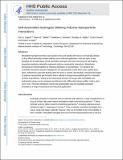Self-assembled hydrogels utilizing polymer–nanoparticle interactions
Author(s)
Mattix, Bradley A.; Veiseh, Omid; Webber, Matthew; Tibbitt, Mark W; Langer, Robert S; Appel, Eric; ... Show more Show less
DownloadLanger_Self-assembled.pdf (1.502Mb)
OPEN_ACCESS_POLICY
Open Access Policy
Creative Commons Attribution-Noncommercial-Share Alike
Terms of use
Metadata
Show full item recordAbstract
Mouldable hydrogels that flow on applied stress and rapidly self-heal are increasingly utilized as they afford minimally invasive delivery and conformal application. Here we report a new paradigm for the fabrication of self-assembled hydrogels with shear-thinning and self-healing properties employing rationally engineered polymer–nanoparticle (NP) interactions. Biopolymer derivatives are linked together by selective adsorption to NPs. The transient and reversible interactions between biopolymers and NPs enable flow under applied shear stress, followed by rapid self-healing when the stress is relaxed. We develop a physical description of polymer–NP gel formation that is utilized to design biocompatible gels for drug delivery. Owing to the hierarchical structure of the gel, both hydrophilic and hydrophobic drugs can be entrapped and delivered with differential release profiles, both in vitro and in vivo. The work introduces a facile and generalizable class of mouldable hydrogels amenable to a range of biomedical and industrial applications.
Date issued
2015-02Department
Massachusetts Institute of Technology. Department of Chemical Engineering; Massachusetts Institute of Technology. Department of Materials Science and Engineering; Koch Institute for Integrative Cancer Research at MITJournal
Nature Communications
Publisher
Nature Publishing Group
Citation
Appel, Eric A., Mark W. Tibbitt, Matthew J. Webber, Bradley A. Mattix, Omid Veiseh, and Robert Langer. “Self-Assembled Hydrogels Utilizing Polymer–nanoparticle Interactions.” Nat Comms 6 (February 19, 2015): 6295.
Version: Author's final manuscript
ISSN
2041-1723